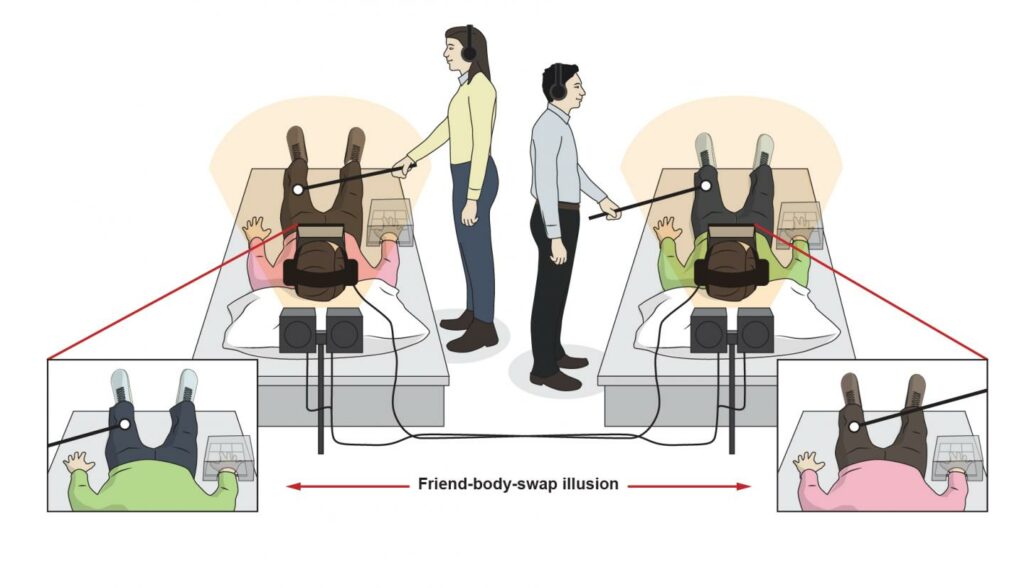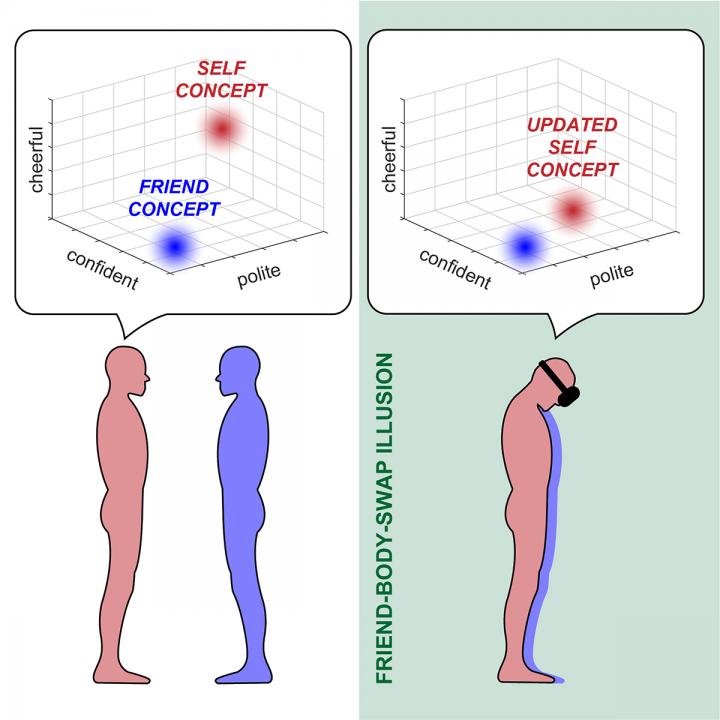
If you haven’t been absorbed in deep philosophical thought in a while, here’s some research that might rev up that old friend of yours: existential angst. You’ve been warned.
In a new study published today in the journal iScience, researchers at the Karolinska Institutet in Sweden pulled off a real-life Freaky Friday, employing a perceptual illusion that had pairs of friends swap bodies.
Remarkably, the participants who inhabited their friend’s avatar started to exhibit behaviors and beliefs that reflected their friend’s personalities rather than their own. As such, these findings show that our psychological sense of self is deeply rooted in our physical sense of self.
“We found that during the perceptual “friend-body-swap” illusion, the participants rated their own personality characteristics more similar to the way they previously rated their friend’s personality. This main finding suggests that our beliefs about own personality (self-concept) are flexibly adjusted to the perception of our body (bodily self) in order to provide a coherent sense of self in a current situation,” lead author Pawel Tacikowski, a postdoctoral researcher at Karolinska Institutet in Sweden, told ZME Science.
“Apart from pure curiosity, I research the sense of self because it is clinically relevant. Some psychiatric disorders, like depersonalization disorder or schizophrenia, are related to atypical experiences of one’s own self. My goal as a cognitive neuroscientist is to formulate a general model of the self-representation at different levels to help develop new treatments.”
Just another Freaky Friday
In order to trigger the body-swap illusion, pairs of friends had to wear goggles that showed first-person live feeds of their friend’s perspective. From time to time, both participants’ bodies were touched at exactly the same time and on the same body parts so that what they saw and what they felt was congruent.
Generally, the illusion worked within less than a minute of getting comfortable with this setup. When the researchers used a prop knife to threaten the friend’s body, the partnered participant flinched as if they were the ones being truly threatened.

“Following this admittedly complicated procedure was a bit challenging in the beginning, but once me and the other experimenter – Marieke Weijs – had conducted the study a few times, everything became easier. The advantage of working with another experimenter is that you can help each other when something goes wrong. It worked really great in this case,” Tacikowski said.
“I remember when we were preparing the illusion, one of the participants jokingly said to his friend: “Stop moving my toes!”, which was very funny but also quite telling, I think. We know that the friend-body swap illusion worked because the majority of participants showed increased physiological stress responses when the friend’s body was physically threatened with a prop knife.”
That being said, the illusion didn’t last long before each participant regained their true sense of self — but it worked long enough for the researchers to notice significant behavioral alterations. Specifically, each participant tended to mirror their paired friend’s personality traits.
The researchers could objectively come to this assessment because they had the friends rank each other on traits like talkativeness, cheerfulness, independence, and confidence before the body swap. During the actual body swap, the participants tended to rate themselves as more similar in personality to the friend whose body they were perceptually inhabiting.
When the illusion interfered with the participants’ self-representations, they also tended to perform worse on memory tests. What’s more, those who tended to fully embrace their friend’s body as their own performed better on memory tests than those who felt disconnected from their friend’s avatar.
People tend to remember things better when they are related to themselves. Those who performed worse on memory tests and also felt more disconnected during the body swap could be exhibiting “self-incoherence”, meaning their mental and physical self-representations are misaligned.
“For me, these findings provide a striking example of self-unity – the illusion introduced incoherence between the bodily and conceptual aspects of one’s sense of self but this incoherence was quickly resolved by the participants adjusting their self-concept to their “new” body,” Tacikowski said.
“Our study challenges a common assumption that the self-concept is largely fixed over time and determined only by factors like our past experiences or social relationships. Instead, these findings highlight the importance of the body in the continuous construction of our psychological sense of self.”
The findings may help improve scientists’ understanding of how depersonalization disorders occur and, conversely, lead to better treatments. For instance, patients suffering from clinical depression often have very negative perceptions and beliefs about themselves.
“The body-perception induced fluidity of self-concept that we demonstrate here could have important implications for applied psychology and for the general public. For example, with some adjustments, the illusion can be used as a therapeutic tool to promote more positive and less rigid views of oneself in depression or to develop a deeper understanding between people by allowing them to literally experience the world from another person’s perspective,” Tacikowski said.
As for Tacikowski and colleagues, the researchers plan to perform more sophisticated experiments that may reveal causal brain mechanisms that may explain body-swapping illusions and the perception of one’s self in general.
“Right now, my mind is occupied with the question of how this effect works at the neural level – “What is the mechanism?”. So next, me and my supervisor from the Brain, Body, and Self Laboratory at Karolinska Institute, Prof. Henrik Ehrsson, we want to induce a similar illusion in an fMRI scanner,”


